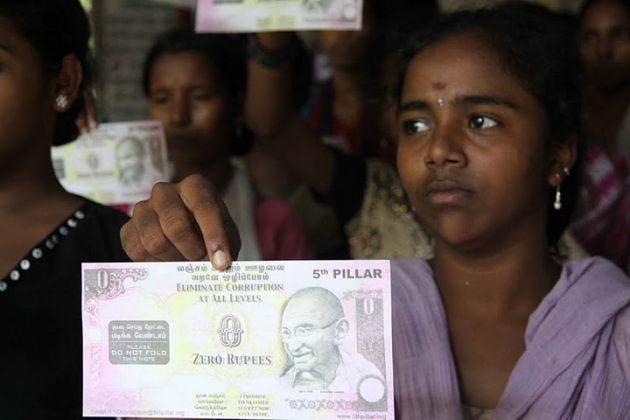It looks like a 50-rupee note, but it’s more like a slap in the face to corrupt officials.
Where a bribe is expected, the Indian anti-corruption organization 5th Pillar is encouraging citizens to pass over zero-rupee banknotes it has created. The notes read “I promise neither to accept nor give bribe.”
They are made to look like 50-rupee notes, the notes that incidentally carry the portrait of Mahatma
Gandhi on them. The 50s are replaced by zeros, and the note also reads, “eliminate corruption at all levels.” It is printed in different languages for different locales in India.
The first 25,000 notes were printed in 2007 in Chennai, the capital of Tamil Nadu State. The success of the campaign inspired 5th Pillar to expand into all the other states. To date, the organization has printed nearly half a million notes.
“Zero rupee has turned out to be a very successful way to do well in situations when a conductor, a police [officer], or [another] official makes you bribe him,” said 5th Pillar president Vijay Anand in an interview recorded on the organization’s website. “Facing corruption, anyone can freely express his ‘no’ in this way.”
And it really works, Anand said. Officials often back off upon seeing the note.
Rajesh Chandran, 38, a software developer, told Indian newspaper The National about his success using the note.
“There were several beds in the train, but the worker did not want to give one to me. He said that he would get me a bed only if I paid a bribe. I gave him a zero-rupee note. I looked at him in his eyes, letting him know that I would not pay the bribe. He looked worried and shamed, and within a few seconds, he gave me a bed,” Chandran said.
Anyone can print the anti-corruption currency after downloading the design from the organization’s website. As only one side of the note is printed, it does not violate counterfeiting laws. Though anyone can print it, the money is also distributed by an extensive network of more than 14,000 volunteers.
It’s not all roses though. Several field volunteers have already been attacked and beaten after catching local officials taking bribes.
“That only strengthened my determination to carry on fighting the corruption,” Anand said.
Another anti-corruption initiative is “I Paid a Bribe.” People from all over India share their experiences with corruption. The website, www.IpaidaBribe.com, documents the locations and amounts as people report them. A constant thread of reports flow in.
On July 23, the website front page showed several postings no more than an hour apart.
The most recent post was by a person in Hyderabad, in the state of Andhra Pradesh. This person was taking photographs, when a police officer confiscated his/her camera, saying photography is restricted in the area. The officer reportedly said: “You people are educated. [You] know well what to do next.” The person paid the officer 200 rupees ($3.30). To put it in perspective, that is more than a day’s wage for some in Hyderabad.
The person wrote, “I regret it!”
Transparency International’s 2010 Global Corruption Barometer showed 54 percent of households had paid a bribe within a 12-month period to receive basic services.

Friends Read Free